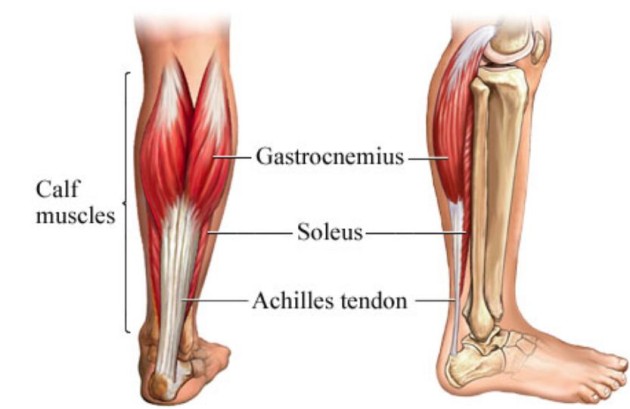
Achilles tendon
The Achilles tendon is a fibrous band that connects the heel of the foot to the two calf muscles. Gastrocnemius is the outside calf muscle the one you can see and feel on the back of your leg. Soleus lies underneath this.
The Achilles tendon is the strongest and thickest tendon in the body. When the calf muscles contract they pull on the achilles which in turn pulls the toes downwards. The calf muscles, and therefore the achilles tendon work every time you take a step to propel your body upwards and forwards.
What are the Symptoms of Achilles Tendon Pain Syndrome?
Achilles tendon pain is a common overuse injury in walkers, runners and sports involving jumping. It’s more common in middle age as the tendon becomes less pliable and more prone to injury.
With Achilles tendon pain syndrome there may be:
– Pain on pressing onto the achilles tendon
– The pain usually comes on gradually over several days or months
– Pain which is worse on exercise and better on rest. Pain increases as the exertion on the tendon increases, so it’s worse on going up stairs or hills, or when increasing speed of running
– When feeling the tendon able there may be a lump and the tendon can feel thicker than normal, or than the other side.
– When feeling the tendon and wiggling the foot up and down there can be a creaking sensation, this is known as crepitus, and is due to swelling in between the tendon and its sheath
– The tendon can feel stiff and painful to move first thing in the morning or after rest
What Causes Achilles Tendon Pain Syndrome?
Some of the factors that can make getting Achilles tendon pain syndrome more likely include:
– Foot position: uncontrolled over pronation (the foot rolling too far over on each foot fall) increases the demands on the achilles.
– Tight calf muscles- this decreases the range of movement available at the ankle and increases foot pronation.
– Inappropriate footwear- sports shoes that don’t give your foot the correct control.
– Wearing high heels lifts the heel and puts the achilles in a shortened position. Ladies who normally wear heels then suddenly switch to wearing flats, for instance when going on holiday or if starting running will frequently have problems.
– Sudden increases in training, particularly activities that stress the achilles most such as hill reps or explosive sprinting
What’s the Treatment for Achilles Tendon Pain?
– In the initial stages ice. A heel raise inside the shoe will raise the heel and take the stretch off the achilles tendon. This can be useful in the short term, but shouldn’t be used as a long term solution.
– Rest or relative rest: avoid provocative activities, change training pattern or cross train whilst the tendon recovers.
– Stretches and eccentric strengthening exercises will help to restore pain free function of the tendon.
– Address any other issues that may be causing biomechanical issues in the lower limb, this may include stiffness in the foot or other muscles or poor core stability.
– Assess footwear; change sports shoes regularly. Keep several pairs on the go at once. Start breaking in the next pair before the old ones are worn out and alternate from the old pair to the new for a while. Make sure shoes give the foot the correct amount and direction of control.
– Heel tabs on your sports shoes can cause friction against the tendon. Many people find relief by putting two vertical slits down heel tab in line with either side of the achilles. This reduces the amount the heel tab is pushed into the tendon on the push off phase of each step.
– Warm up and cool down appropriately before and after exercise.
Read more Physiotherapy articles.
Check out our Interviews section, every Tuesday a new story! Tomorrow read about Łukasz Szarek – “We tried different settings, it did not work out”.